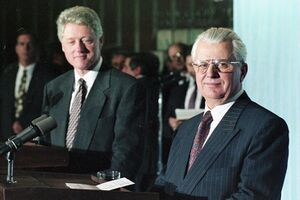Haillet's Crisis: Difference between revisions
(Created page with "{{WIP}}{{Infobox military conflict | conflict = Haillet's Crisis | width = | partof = | image = HailletsCrisis1.jpg | image_size = 300px | alt =...") |
No edit summary |
||
| Line 54: | Line 54: | ||
== Conclusion == | == Conclusion == | ||
Following the signing of the Amiens Treaty, the Cassien government suffered significant backlash from the country's population, which would ultimately cause the nation's abandonment of its longstanding neutral foreign policy and the formation of [[North_Vehemens_Organization|NVO]] between [[Cassier]], [[Halland]] and [[Nuxica]]. This began a rise of tensions between [[Samorspi]] and the three [[Asteria]]n nations. | |||
[[Category:Cassier]] | [[Category:Cassier]] | ||
[[Category:Narozalica]] | [[Category:Narozalica]] | ||
Revision as of 23:55, 19 March 2020
This article is incomplete because it is pending further input from participants, or it is a work-in-progress by one author. Please comment on this article's talk page to share your input, comments and questions. Note: To contribute to this article, you may need to seek help from the author(s) of this page. |
| Haillet's Crisis | |||||||
|---|---|---|---|---|---|---|---|
 Cassien president Jules Ménard (left) and Narozalic president Ivan Lecsko (right) in Armiens, Cassier, in 1993 | |||||||
| |||||||
| Belligerents | |||||||
|
|
| ||||||
| Commanders and leaders | |||||||
|
|
| ||||||
| Casualties and losses | |||||||
| 2 civilian ships seized; later released | None | ||||||
The Haillet's Crisis (Gaullican: La crise de Haillet, Narodyn: Криза Гейлетта; Kryza Hayletta) was a diplomatic standoff and war scare in the early 1990s between the Republic of Cassier and the Narozalic Republic. The crisis stemmed from disagreements over maritime zones and economic zones in the Haillet's Sea, containing rich oil reserves being drilled by both nations. The crisis lasted two years and saw the re-emergence of Narozalica as a global power.
Following Narozalica's second civil war in 1983, Narozalica had lost much of its material overseas possessions and most of its empire, losing the ability for global power projection in the process as the economy and military suffered from four years of infighting. Under Sava Tokar and Vasil Bodnar, Narozalica attempted to rebuild its influence but struggled in the wake of economic crises and instability. Ivan Lecsko's election in 1989 saw a crackdown on major dissent and the reformation of the economy into a mixed-market economy, implementing monetary policies that allowed Narozalica's economy to rebound and post extremely positive numbers in the first 1990 fiscal quarter. Wanting to further Narozalica's influence in natural resources, particularly in the oil market, Lecsko introduced plans to alter Narozalica's Haillet's Sea economic zone to include increased amounts of the proven oil reserves in the sea, overlapping Cassier's established zones in the process.
The zone became effective in Narozalica on October 1, 1991, with the crisis officially beginning on October 7 when the Narozalic Navy seized a Cassien civilian oil tanker travelling through the newly-established zone. Cassier, now concerned over Narozalica's breach of Haillet's agreements, lodged an official diplomatic protest and severely restricted diplomatic staff to Narozalica by 1992, encouraging its close allies to do the same. Another tanker was seized in March 1992, with Narozalica now guarding its newly-established zone by force, ordering Cassien oil drilling platforms to cease operation immediately and return to Cassier. When the staff refused, Narozalica threatened to retaliate with force to enforce their claimed territories in the April of 1992, prompting large-scale international backlash. Fearing a war in the Asterias was imminent, Cassien president Jules Ménard embarked on a series of de-escalations with Narozalica, with the two countries eventually coming to an agreement over oil zones in 1993 with the signing of the Armiens Accords, which saw Narozalica's zone expanded, Cassier's slightly reduced and a major cutback on Narozalica's claimed zone. The crisis still saw tensions between Cassier and Narozalica throughout the rest of the 1990s, and put Narozalica back in the group of global powers. Ménard was commended by his contemporaries following the crisis' conclusion for his prevention of war, while Lecsko was lauded for his gunboat diplomacy methods of negotiation.
Background
Events
Conclusion
Following the signing of the Amiens Treaty, the Cassien government suffered significant backlash from the country's population, which would ultimately cause the nation's abandonment of its longstanding neutral foreign policy and the formation of NVO between Cassier, Halland and Nuxica. This began a rise of tensions between Samorspi and the three Asterian nations.